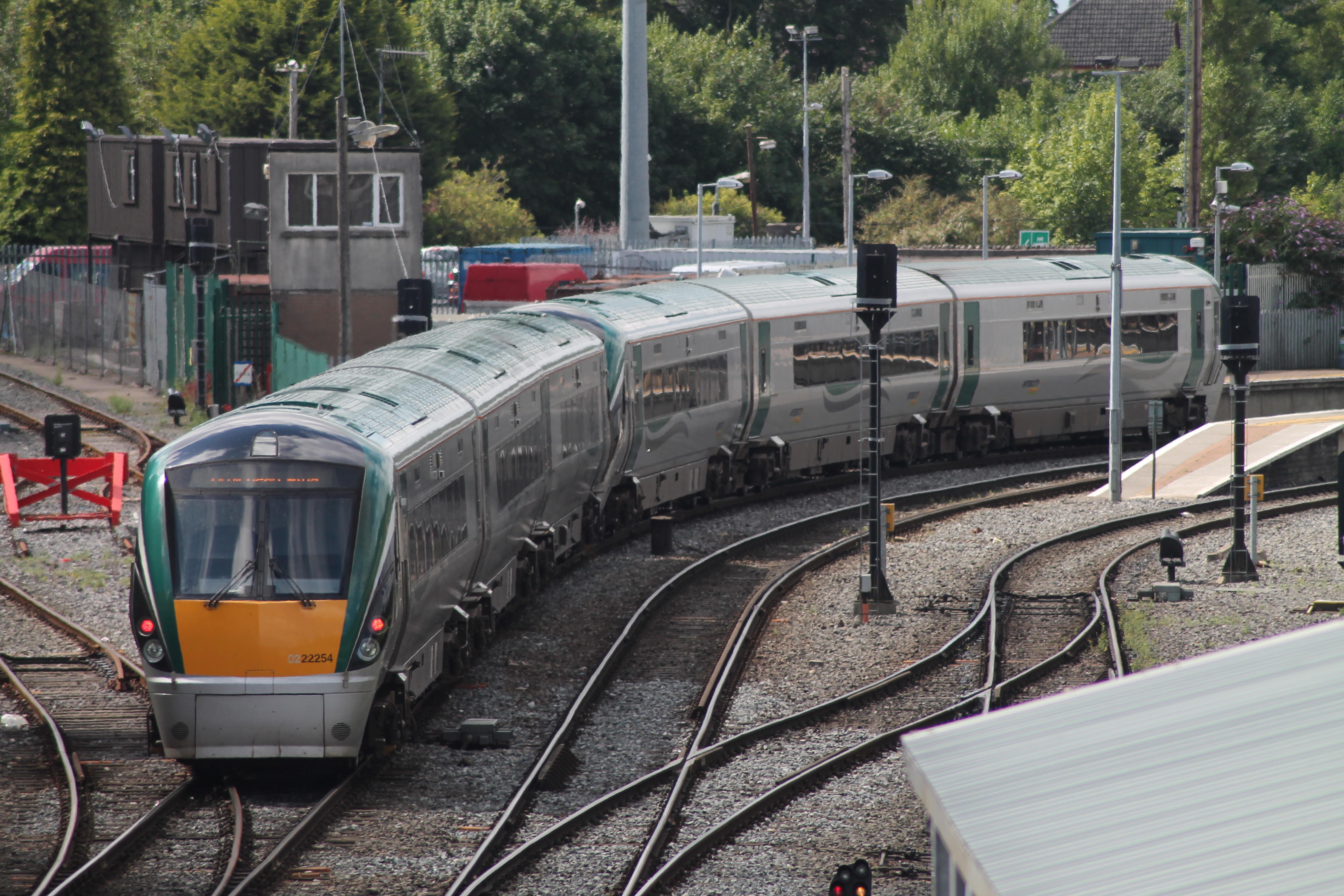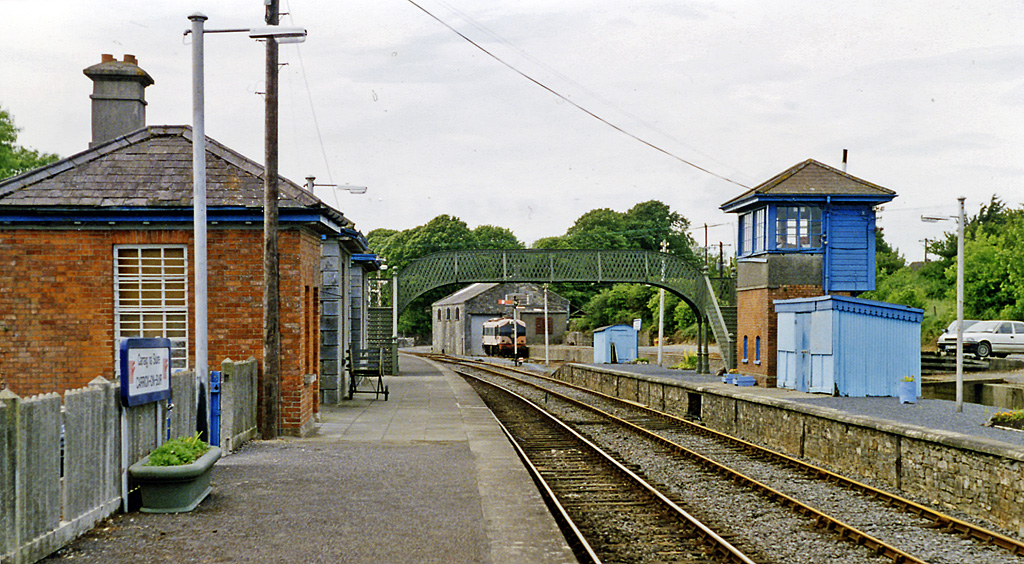|
CIÉ 101 Class
The Córas Iompair Éireann 101 Class locomotives, numbered B101-B112, were built in 1956 by the Birmingham Railway Carriage and Wagon Company. They were fitted with Sulzer 6LDA28 engines of , with four Metropolitan-Vickers MV137 traction motors. They were of A1A-A1A UIC classification, wheel arrangement, weighed 75 tonnes and had a maximum speed of . History With their design, size and axle loading, they were intended for mixed traffic duties, hauling both freight and passenger trains. They found regular use primarily on the Waterford–Mallow railway line, Waterford-Mallow–Tralee railway line, Mallow-Tralee line and also on the Limerick–Tralee railway line, Tralee-Newcastle West-Limerick line. Given that they were the first main group of diesel locos used in Ireland, they proved very successful and quickly gained a reputation for comfort and reliability by contrast to the poor cab conditions and suspension rocking of the CIÉ 113 Class, 113 Class and the interminable breakdow ... [...More Info...] [...Related Items...] OR: [Wikipedia] [Google] [Baidu] |
Birmingham Railway Carriage And Wagon Company
The Birmingham Railway Carriage and Wagon Company (BRC&W) was a railway locomotive and carriage builder, founded in Birmingham, England and, for most of its existence, located at nearby Smethwick, with the factory divided by the boundary between the two places. The company was established in 1854. Production BRC&W made not only carriages and wagons, but a range of vehicles, from aeroplanes and military gliders to buses, trolleybuses and tanks. Nevertheless, it is as a builder of railway rolling stock that the company is best remembered, exporting to most parts of the new and old worlds. It supplied vehicles to all four of the pre-nationalisation "big four" railway companies (London, Midland and Scottish Railway, LMS, Southern Railway (UK), SR, London and North Eastern Railway, LNER and Great Western Railway, GWR), British Rail, Pullman Company, Pullman (some of which are still in use) and Compagnie Internationale des Wagons-Lits, Wagons-Lits, plus overseas railways with dive ... [...More Info...] [...Related Items...] OR: [Wikipedia] [Google] [Baidu] |
Mallow–Tralee Railway Line
The Mallow–Tralee line runs from to Tralee Casement. Intermediate stations include , , , and . A peculiar arrangement at Killarney is in place, in which trains from Mallow enter Killarney, which is a dead-end. Trains continuing to Tralee then have to reverse until they reach the junction, before changing direction again to continue westwards. Irish Rail's network statement gives the length of the line as , though other sources give the length of the line as miles instead. The line from Mallow to Killarney was noted for severe gradients compared to the line from Dublin to Mallow though the Killarney expresses of 1899 were timed to achieve the section at westbound and eastbound. History The (KJR) completed the construction of the line from to the holiday resort of Killarney in 1853. The opened the extension from Killarney junction to Tralee in 1859. The Great Southern and Western Railway (GS&WR) who had invested in both companies absorbed them both in 1860. At Tral ... [...More Info...] [...Related Items...] OR: [Wikipedia] [Google] [Baidu] |
BRCW Locomotives
BRCW may refer to: * Birmingham Railway Carriage and Wagon Company, railway locomotive and carriage builder * Black Ridge Canyons Wilderness The Black Ridge Canyons Wilderness (BRCW) is located in western Colorado with a small portion extending into eastern Utah, USA, within the arid Colorado Plateau region approximately west of Grand Junction, Colorado. The wilderness lies on the ..., Wilderness located in western Colorado * Boca Raton Championship Wrestling, American independent professional wrestling promotion based in Boca Raton, Florida {{disambiguation ... [...More Info...] [...Related Items...] OR: [Wikipedia] [Google] [Baidu] |
British Rail Class 24
The British Rail Class 24 diesel locomotives, originally known as the Sulzer Type 2, were built from 1958 to 1961. 151 were built at Derby, Crewe Crewe () is a railway town and civil parish in the unitary authority of Cheshire East in Cheshire, England. At the 2021 United Kingdom census, 2021 census, the parish had a population of 55,318 and the built-up area had a population of 74,120. ... and Darlington Works, Darlington, the first twenty of them as part of the British Railways 1955 Modernisation Plan. This class was used as the basis for the development of the British Rail Class 25, Class 25 locomotives. The final survivor, no. 24081, was withdrawn from Crewe Diesel TMD, Crewe depot in 1980. Technical details Engine The main power for the class 24 was the Sulzer (manufacturer), Sulzer 6LDA28 diesel engine - denoting 6 Cylinder (engine), cylinders; Locomotive use; Direct fuel injection; (Turbocharger, turbo-charged); Bore (engine), bore cylinders. This was effectively ... [...More Info...] [...Related Items...] OR: [Wikipedia] [Google] [Baidu] |
OO Gauge
OO gauge or OO scale (also, 00 gauge and 00 scale) is the most popular standard gauge model railway standard in the United Kingdom, outside of which it is virtually unknown. OO gauge is one of several 4 mm-scale standards (4 mm to , or 1:76.2), and the only one to be marketed by major manufacturers. The OO track gauge of (same as the 1:87 HO scale) corresponds to prototypical gauge of , rather than standard gauge. However, since the 1960s, other gauges in the same scale have arisen – 18.2 mm ( EM) and 18.83 mm ( Scalefour) — to reflect the desire of some modellers for greater scale accuracy. Origin Double-0 scale model railways were launched by Bing in 1921 as "The Table Railway", running on track and scaled at 4 mm to the foot. In 1922, the first models of British prototypes appeared. Initially all locomotives were powered by clockwork, but the first electric power appeared in 1923. "OO" describes models with a scale of 4 mm = 1 foot (1:76) ... [...More Info...] [...Related Items...] OR: [Wikipedia] [Google] [Baidu] |
Iarnród Éireann
Iarnród Éireann, () or Irish Rail, is the operator of the national Rail transport in Ireland, railway network of Ireland. Established on 2 February 1987, it is a subsidiary of CIÉ, Córas Iompair Éireann (CIÉ). It operates all internal InterCity (Iarnród Éireann), InterCity, Commuter (Iarnród Éireann), Commuter, Dublin Area Rapid Transit, DART and freight railway services in the Republic of Ireland, and, jointly with Northern Ireland Railways, the Enterprise (train service), Enterprise service between Dublin and Belfast. In 2019, IÉ carried a record peak of 50 million passengers, up from 48 million in 2018. Until 2013, Ireland was the only European Union state that had not implemented First Railway Directive, EU Directive 91/440 and related legislation, having derogation, derogated from its obligation to split train operations and infrastructure businesses, and allow Open access (infrastructure), open access by private companies to the rail network. A consultation on ... [...More Info...] [...Related Items...] OR: [Wikipedia] [Google] [Baidu] |
Carrick-on-Suir Railway Station
Carrick-on-Suir railway station serves the town of Carrick-on-Suir, County Tipperary in Ireland Ireland (, ; ; Ulster Scots dialect, Ulster-Scots: ) is an island in the North Atlantic Ocean, in Northwestern Europe. Geopolitically, the island is divided between the Republic of Ireland (officially Names of the Irish state, named Irelan .... It has a weekday passenger service of two trains to Waterford and two to Limerick Junction. There is no Sunday service. Until 19 January 2013 (inclusive) there were three trains each way. However the late-morning Waterford to Limerick Junction and early-afternoon Limerick Junction to Waterford trains are now discontinued. The station consists of two platforms, a waiting room, toilets and small car park at present free for rail passengers. The second platform, on which the signal cabin is located, was served by a passing loop until November 2013. There is also a siding, used by the Irish Traction Group to store preserved diesel loco ... [...More Info...] [...Related Items...] OR: [Wikipedia] [Google] [Baidu] |
Irish Traction Group
The Irish Traction Group is a railway preservation society dedicated to preserving diesel locomotives from Iarnród Éireann, Irish railways. It was founded on 4 June 1989 with the intention of attempting to preserve at least one example of every type of diesel locomotive to have operated on the Irish Rail system. The ITG's locomotives and work are spread across three sites: Carrick-on-Suir railway station, the Downpatrick and County Down Railway (DCDR), and the West Clare Railway. Locations When the ITG was first set up, Iarnród Éireann (IÉ) were reluctant to sell any locomotives to the group until they had a location to store them. IÉ offered the group use of the disused goods sheds at Portarlington railway station, Portarlington or Carrick-on-Suir railway station, Carrick-on-Suir in December 1990. Portarlington was initially preferred due to its better condition, connection to the Dublin–Cork railway line, Dublin–Cork mainline, and closer proximity to Dublin city. How ... [...More Info...] [...Related Items...] OR: [Wikipedia] [Google] [Baidu] |
CIÉ 071 Class
The Córas Iompair Éireann/Iarnród Éireann 071 Class or Northern Ireland Railways 110 Class or Serbian Railways JŽ series 666 is a General Motors Electro-Motive Division EMD JT22CW series diesel–electric locomotive used in the Republic of Ireland, Northern Ireland and Serbia. Córas Iompair Éireann The Córas Iompair Éireann 071 Class locomotives were the principal passenger locomotives on the Irish railway network for twenty years from their introduction in the late 1970s. They displaced the older CIÉ 001 Class and NIR 101 Class locomotives and were themselves replaced in turn by the new 201 Class locomotives. Currently all the CIÉ locomotives remain in service, being used on freight and permanent way trains. NIR 112 was on long-term loan to Iarnród Éireann from April 2003 until September 2006, when it was returned to Northern Ireland Railways. The locomotives arrived in Ireland on 2 November 1976 and were purchased to facilitate 90 mph running on the ... [...More Info...] [...Related Items...] OR: [Wikipedia] [Google] [Baidu] |
CIÉ 181 Class
The Córas Iompair Éireann 181 Class locomotives were built in 1966 by General Motors Electro-Motive Division (EMD) and numbered B181 to B192. Overview These locomotives were virtually identical to the earlier 141 Class locomotives, but fitted with the more powerful 645 engine and thermostatically controlled engine cooling fan and inlet shutters. Delivery took place in 1966, with introduction into service happening a short time later. They were fitted with an EMD 8-645E engine of 1100 hp, weighed , and had a maximum design speed of which was restricted to in service. Number 186 was later fitted with an EMD 8-567CR engine of , as used in the 141 Class locomotives. Withdrawal and preservation All of the 181 class have been withdrawn, the first being 191 in 1991 after a runaway incident at Clonsilla; it was later scrapped in 1998. In their final days they were only used on permanent way trains or as pilots. The last of the class to be withdrawn was 190 in November 20 ... [...More Info...] [...Related Items...] OR: [Wikipedia] [Google] [Baidu] |
CIÉ 201 Class
The Córas Iompair Éireann 201 Class was a class of 34 diesel electric locomotives manufactured by Metropolitan-Vickers at their Dukinfield Works in Manchester. They were a smaller, lighter and less powerful version of the CIÉ 001 Class, 001 Class and were originally intended for branch line passenger and freight (mixed traffic) duties. They were introduced in 1956 and, although their duties changed over the years, were in regular service on the Irish railway network until the mid-1980s. Six were sold to Northern Ireland Railways (NIR) in 1986. Service history Unfortunately, these locomotives suffered from two distinct problems: * During the late 1950s and early 1960s, following the publication of the Todd Andrews#CIE, Andrews Report (mimicking the widescale Beeching cuts in Britain), CIÉ undertook large-scale closures of branch lines, leaving the engines without a purpose. *The locomotives were of insufficient power for their duties and their Crossley engines suffered relia ... [...More Info...] [...Related Items...] OR: [Wikipedia] [Google] [Baidu] |






